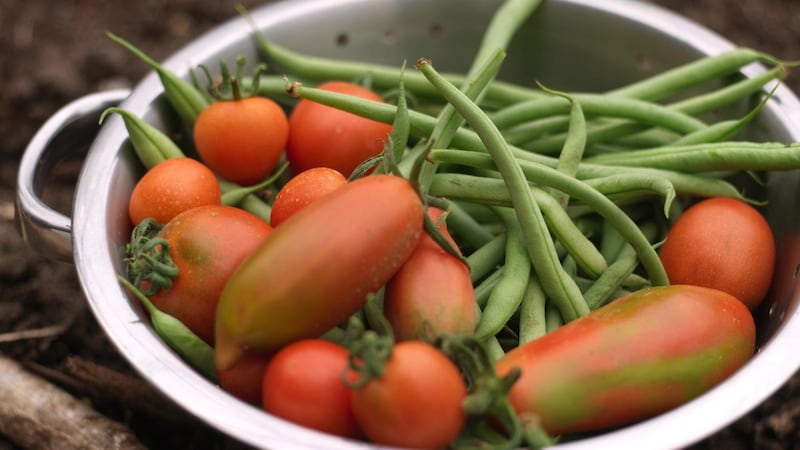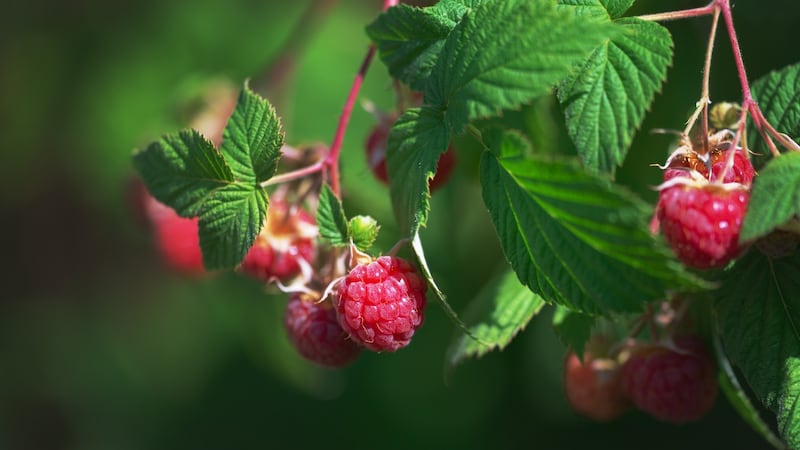If you’re a keen kitchen gardener, you’ll know it has been an exceptionally challenging year for people who like to grow a little of their own food, from winter blizzards and a late, cold spring that blighted attempts to get seed and young plants in the ground to the summer’s searing, lengthy drought which dramatically reduced yields and stunted growth. An example is early cropping potatoes – the mainstay of many Irish allotments – which were almost impossible to sow on time because the ground was so cold and waterlogged. Conversely, the later, main potato crop then suffered terribly from a shortage of water.
Carrots, onions, beetroot, peas and lettuce also struggled with the prolonged shortage of rainfall and intense heat, as did brassica crops including cabbage, cauliflower and broccoli.
True, it wasn’t all bad. Many of the country’s tomatophiles had their best crop in decades – all that sustained heat and intense sun helped to ripen and sweeten the fruit, producing bumper yields. Courgettes grew like billy-o and despite a rocky start, it’s been a bumper year for fruit; I’ve been eating ripe raspberries from the garden for several months now while the trees are laden with apples.
But still, the erratic weather patterns of late are deeply worrying.
So what lessons can the country’s kitchen gardeners take from this oh-so-strange and sometimes terrible growing season?
If there’s one above all others, it’s to be prepared; to have vegetable beds and polytunnels winter-proofed and prepped well in advance, for example, so that when the time comes to plant them, the soil will be hale and hearty as well as warm-ish and weed-free.

With that in mind, my suggestion is to take the opportunity in the coming weeks to clear empty beds of the remains of finished crops before blanketing the soil with a generous layer (5cm-7.5cm deep) of well-rotted manure, seaweed (just make sure it’s harvested sustainably and with permission), leaf mould and/or well-rotted garden compost.
Alternatively, if these are hard to get hold of, then get your hands on a few bags of Gee-Up, the Irish-produced soil enricher made from horse manure. Once spread, cover this organic mulch with the sort of strong black polythene sheeting farmers use to bale silage and which you can buy in rolls from good hardware shops. Secure this against possible fierce winter winds, storms and gales by stretching it taut over the surface of the beds, then use the pointed end of a garden spade to tuck the edges almost the depth of the blade into the ground (don’t worry, this won’t tear or cut it).
As for established trees and fruit bushes, check that any tree stakes and ties are secure against strong winds
This method also works very well for badly neglected, overgrown beds where weeds have long ago got the upper-hand. Just cut or strim the weeds back to ground level before mulching, while making sure to remove and bin any seed-heads that might result in a future crop of weed seedlings.
Left on the ground until next spring, the plastic sheeting will slowly deprive the weeds’ root systems of light, killing them off without the need for heavy digging. It will also help to protect the soil from winter cold, flooding and compaction caused by heavy rain while encouraging the activity of earthworms. The latter will then do all the hard work of incorporating the organic mulch beneath the plastic into the soil, again saving you from any heavy digging.
Green manures are yet another way of nourishing your garden or allotment’s soil while protecting it from weather extremes and boosting populations of beneficial soil micro-organisms.
Varieties suitable for sowing at this late stage of the year include field beans, forage rye (also known as Hungarian grazing rye) and caliente mustard.
Last but not least, consider adding a few sprinkles of Soil Renew, an innovative, organic soil additive that uses the action of beneficial soil micro-organisms to encourage the rapid production of humus, which is key to soil health, resilience and fertility. Many professional gardeners swear by its many benefits, from an explosion in the size of a garden’s earthworm populations to greater yields, tastier crops, stronger and steadier growth levels, and a significant reduction in plant pests and diseases.

Prepping beds aside, the same warning regarding the unpredictability of future weather patterns holds true when it comes to planting bare-root fruit trees and shrubs.
Where once we could have relied upon a relatively mild, dry spell in late winter and early spring to get these plants in the ground, followed by sufficient rainfall to help their root systems to get established before the arrival of summer, those certainties belong to an era before climate change. So my advice is not to wait until early spring but to plant them later this autumn once the bare root-season (which typically lasts from November-March) kicks in.
As for established trees and fruit bushes, check that any tree stakes and ties are secure against strong winds, and loosen or remove any that are overly-tight or not needed anymore. Then weed and shallowly mulch around the base of the plants to help prevent fresh weed growth and to lock in moisture (but only do this once the ground is already moist from autumn rains). Again, you can use well rotted manure, garden compost, seaweed, leaf mould or Gee-Up. Just make sure the mulch is not in direct contact with the trunk/ branches as it can cause problems with disease and decay.
Finally, remember that October is also an excellent time to plant hardy overwintering crops in the kitchen garden or allotment such as onions (suitable varieties include ‘Radar’ and ‘Troy’), shallots (suitable varieties include ‘Jermor’ and ‘Griselle’); garlic (suitable varieties include ‘Vallelado’, ‘Lautrec Wight’, ‘Cristo’, ‘Thermidrome’, ‘Marco’ and ‘Solent Wight’; to sow seed of broad beans (suitable varieties include ‘Claudia Aquadulce’ and ‘Super Aquadulce’); to sow peas (suitable varieties include ‘Douce Provence’, ‘Meteor’, ‘Feltham First’ and ‘Kelvedon Wonder’) and to plant rhubarb (suitable varieties include ‘Timperley Early, ‘Hawke’s Champagne’ and the autumn-cropping Livingstone).
And there you were thinking it was time to put your feet up . . .
This week in the garden
Fresh, ripe seed is being produced by many plants at this time of year including many kinds of ornamental trees, shrubs, perennials, biennials, annuals and vegetable plants and is well worth saving for later use or to share with gardening friends. Examples include cerinthe, ammi, sweet pea, nigella, orlaya, calendula, tagetes, opium poppy, astrantia, thalictrum, honesty, Sweet William, verbena, species roses, acer sp. and crataegus sp. and many heritage varieties of vegetables including broad beans, French beans, runner beans, peas, tomatoes, chillies and peppers as well as herbs such as dill, parsley and coriander.
Not only does home seed-saving save you money and the hassle of sourcing seed elsewhere but it also helps to preserve genetic diversity and promote resilience.
For lots more information on how to save seed from your garden or allotment, visit the website of Seed Savers Exchange (seedsavers.org). Also, see below for details of Irish Seed Savers upcoming seed saving workshop.
While the recent fine, dry weather might tempt you to start cutting back faded plants in flowerbeds and borders, it’s a good idea to hold off until early next spring as their old stems, foliage, flower-heads and seed-heads will provide food, shelter and useful habitats for garden wildlife in search of a place to overwinter. Many faded flowers and seed-heads are also of ornamental use in the winter garden, yet another good reason to leave them standing until next spring.
With more autumn storms almost certainly on their way in the months ahead, try to make sure that garden structures such as polytunnels, glasshouses, sheds, pergolas, arbours and treehouses are sound and in good repair. It’s a good time to make any repairs such as replacing broken or cracked panes of glass, patching polythene sheeting by using repair tape, and replacing damaged doors, locks, catches and hinges. Remember the doors and vents of glasshouses and polytunnels should be securely closed whenever storms or high winds are forecast to protect them from structural damage.
Dates for your diary
Wednesday, October 10th, (8.15pm), St Patrick's Recreation Centre, Greystones, Co Wicklow, "The Life & Travels of a Horticulturalist," autumn lecture by Tim Weldon on behalf of Delgany & District Horticultural Society; Friday, October 12th, Kilmacurragh Gardens, Co Wicklow (10.30am-3.30pm) "Beginners Photography Workshop with the Outdoor Studio", a one-day photography workshop in the gardens suitable for beginners and enthusiasts, €35, booking essential, see skerriesphotography.com or tel: 01-8492572; Saturday, October 13th, (10am-4.30pm) Irish Seed Savers, Scariff, Co Clare, "Introduction to Seed Saving, a practical workshop on how to home-save seeds", book via nots.ie or tel: 061-921866, €52.50-€70; Saturday and Sunday, October 13th-14th, "Adapting to Climate Change", Community Gardens Ireland autumn gathering, Scariff Community Garden, Irish Seed Savers and Moyhill Community Farm, tickets from €25 includes lunch and refreshments, see eventbrite.com and cgireland.org for booking details.





















